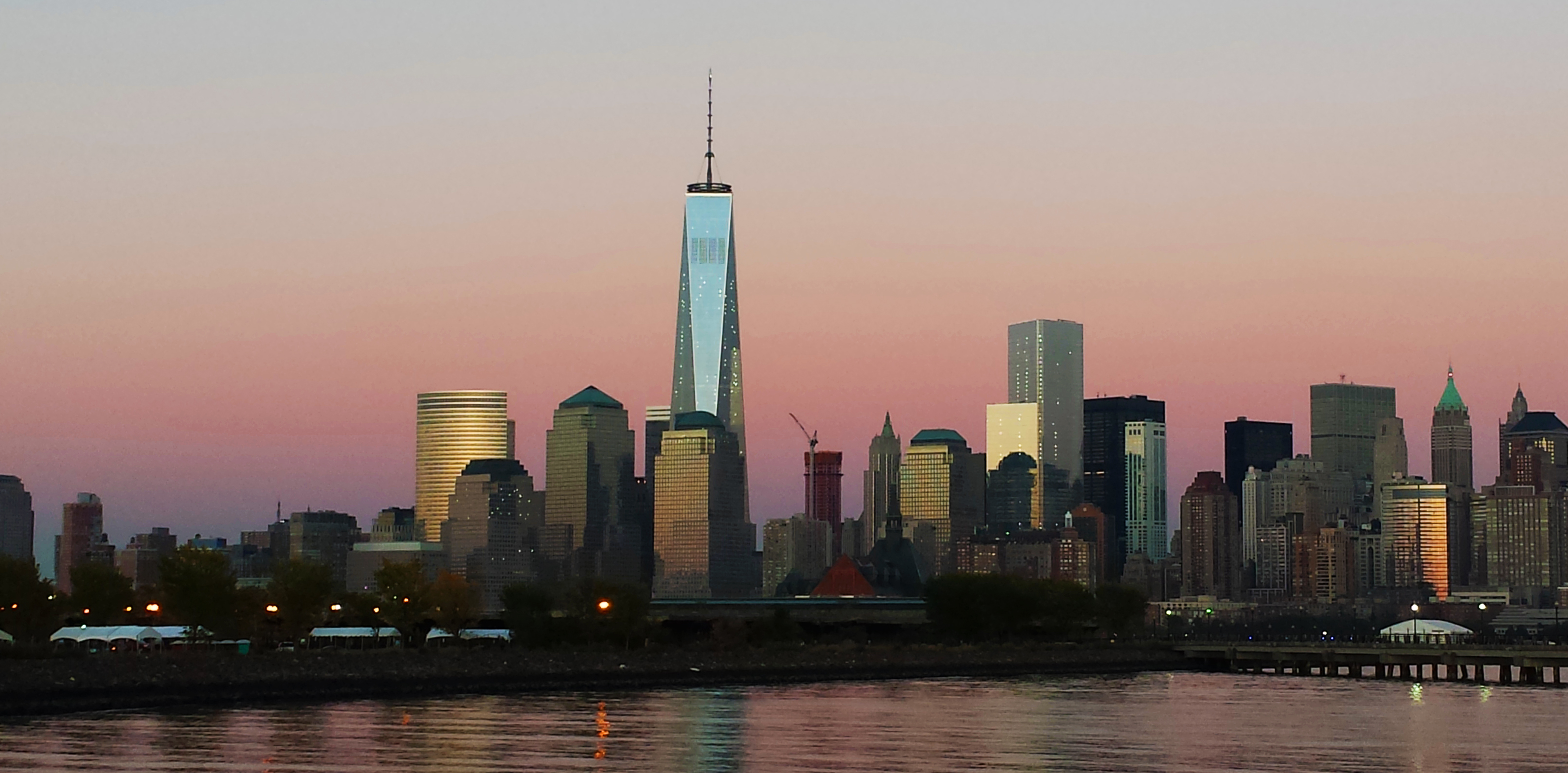
Homecoming
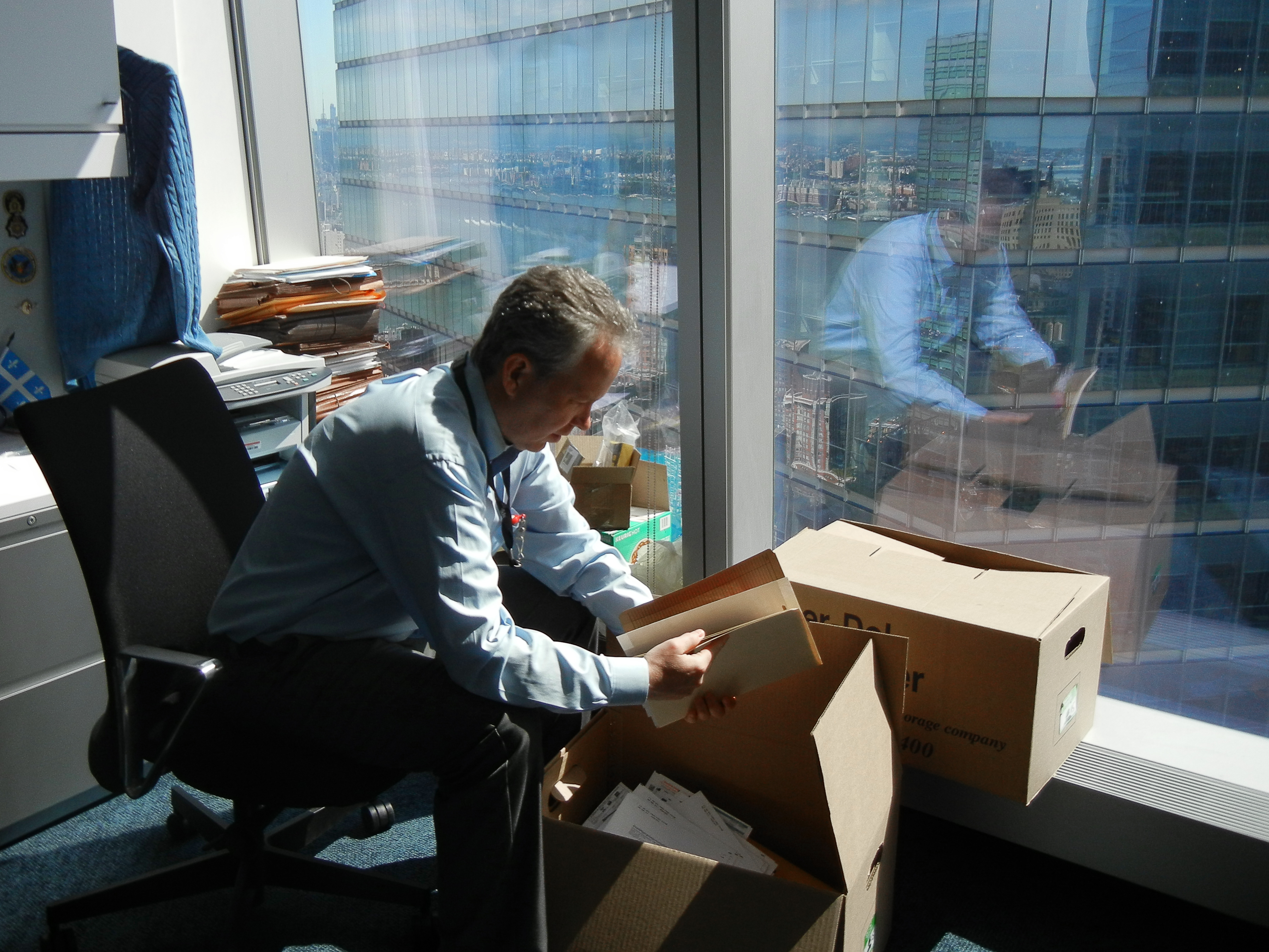
The Manhattan skyline at night with a gleaming One World Trade Center towering above other skyscrapers. At 1,776 feet, One World Trade Center is the tallest building in the Western Hemisphere and the fourth tallest building in the world. Photo by Stephen Zuk
As far back as Colleen Piccone can remember, the World Trade Center was always a part of her life. Growing up on Staten Island in the early 1970s, she watched from across the New York Harbor as the Twin Towers were being built. After graduating from Brooklyn Law School, she started working at 6 World Trade Center for the U.S. Customs Service, one of U.S. Customs and Border Protection’s legacy agencies. “It was my first legal job,” said Piccone, who is now CBP’s associate chief counsel in New York.
It also was the only place at U.S. Customs that Piccone had ever worked until September 11. But on that day, she wasn’t in the building. She was headed to San Diego for training when her flight was grounded in Las Vegas after the Twin Towers were attacked.
Others such as Nina Rohan, a national import specialist associate who had worked 21 years at 6 World Trade Center for the U.S. Customs Service, were there that day. “We had a seminar for all of our wearing apparel folks. They came in from all over the country,” said Rohan. But just as the meeting was getting underway, there was a loud “KABOOM” and the room started shaking. The seminar host made a joke, recalled Rohan. “’You didn’t know we had earthquakes in New York,’ he said. Everybody was laughing, and then all of a sudden we heard a voice yell, ‘Get out! Get out now!’”
Denise Faingar would have been at the building that day, but she was out sick. Faingar, a supervisory import specialist at the time, was at her mother’s home on Long Island while her mother, who also worked for U.S. Customs, was at 6 World Trade Center at the seminar. “I worried terribly for her and all of my colleagues,” said Faingar, now one of CBP’s national commodity specialist branch chiefs.
Faingar’s mother called. She and her coworkers had gotten out of the building safely, but that’s all Faingar knew. “I tried to contact her after the second building was hit and couldn’t reach her. Just the waiting and not knowing what happened was agonizing,” said Faingar.
Immediately following the attacks on 9/11, the U.S. Customs Service was displaced. Some employees moved to Newark, others to JFK International Airport, and within weeks the New York Field Office was relocated to midtown Manhattan at One Penn Plaza. Miraculously, every employee of the Customs Service had survived. However, it was the first time in the agency’s 212-year history that the customhouse, the government building for collecting duties and clearing vessels, was not headquartered in lower Manhattan. Even the original customhouse, built by the British before America’s independence, was located on the southern tip of Manhattan.
“There was a strong feeling among many that the government needed to reconstitute a presence in lower Manhattan,” said Robert Perez, CBP’s director of field operations in New York. But it wasn’t until 2014 that a final decision was made for CBP to move back to the newly reopened World Trade Center.
returned to lower Manhattan, moving to the soaring,
104-story One World Trade Center, built on the
former customhouse site. Photo by Marcy Mason
Earlier this year, after a 15-year hiatus, CBP’s New York Field Office returned to its roots, moving to the 50th and 51st floors of the soaring, 104-story One World Trade Center. With its spire, it is the tallest building in the Western Hemisphere. Moreover, the building, a gleaming monolith, rises from the ashes of 6 World Trade Center. “The building sits on the very footprint of our former customhouse,” said Perez. “It sends a great message of resiliency and instills a sense of pride. It’s so much more than just a building or just an office; it’s really a celebration of everything that CBP stands for and why it was created.”
But then there are the challenges of getting people to work in a building that was a target. “A lot of people have a legitimate fear,” said Piccone, “but I think it was really important for us to come back, especially being part of the Department of Homeland Security. If we’re not coming back, who is? But then it dawned on me that there are a lot of mixed feelings about coming back,” said Piccone. “I’m very proud that in the end, about 75 percent of the employees at One Penn Plaza did come back. Everybody was given an option. Nobody was forced to come back. It was done very, very sensitively.”
At first, Todd Smith had some concerns about returning. “I definitely was a little apprehensive,” said Smith, CBP’s deputy associate chief counsel in New York, who was at 6 World Trade Center on September 11. “Initially, the word was that we were going to be on a lower floor, but then it turned out that we were up higher. It really took going through the move and settling in here to realize that it’s a great place to work. It’s a very comfortable atmosphere. Coming in and working here day-to-day, I really don’t think about it very much anymore.”
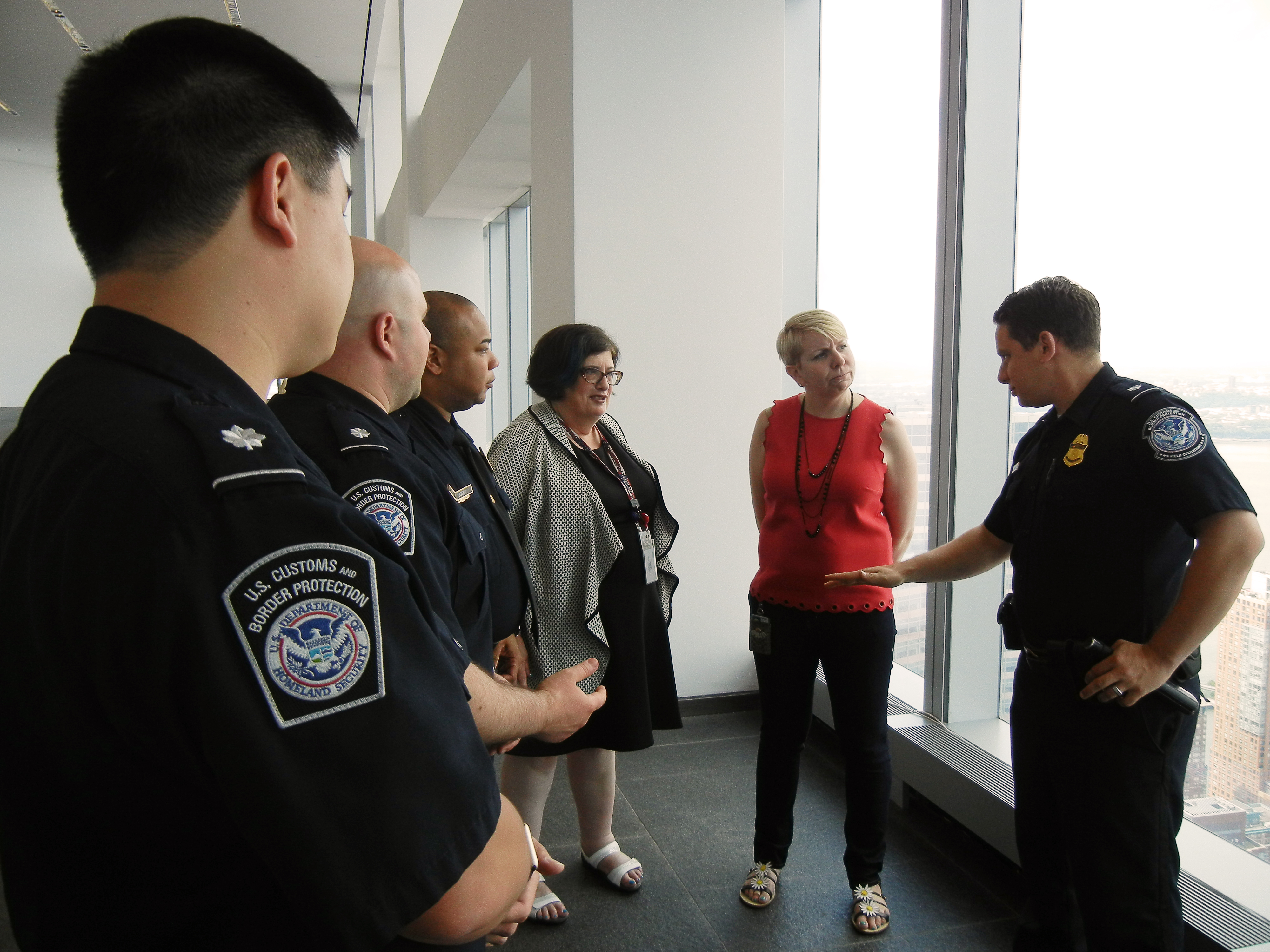
Leon Hayward had no reservations about working in the building. “Looking at how this place was being built, I knew that it was going to be very safe,” said Hayward, the assistant director of field operations for trade and cargo security at the New York Field Office. The building uses a layered approach to security. For example, street traffic isn’t allowed near the building; there’s no underground parking; a vehicle receiving area will be located two blocks away; and delivery vehicles coming to the building will be screened. “They’ll go through the same kind of screening that we apply to vehicles that cross the border into the U.S.,” said Hayward.
Inside the building, security is also rigorous. One elevator bank is dedicated solely to government-leased floors, but CBP took it a step further and programmed the elevators. “We made sure that only our employees had access to our floors. That was a requirement that we put in,” said Perez.
One of the best perks of the building is its views. “We literally have million-dollar views,” said Hayward. “From my office I can see every other skyscraper in Manhattan as well as the Hudson River as it flows into the New York Harbor. Sometimes it’s a little hard to remember to turn around and go back to work once I’ve looked out the window and seen what’s in front of me.”
Hayward’s wife, Rosemarie, a national import specialist, wasn’t sure she wanted to come back. She had worked at the World Trade Center when she started her career in the mid-1990s. “I just kept thinking I can’t expect my husband to go there and not go myself,” she said. But then she had second thoughts. “When the anniversary of 9/11 came rolling around, I felt anxious. I thought about asking if I could be placed somewhere else, but then I realized if I lived in fear, I wouldn’t do any of the things I should do in life,” said Rosemarie. “I’m not going to let fear run my life. So a lot of days, I don’t think about where I am. I just go in, do my job, go home, and not think that I’m on the 51st floor of Building One. I’m going to just live my life and try to enjoy each day.”
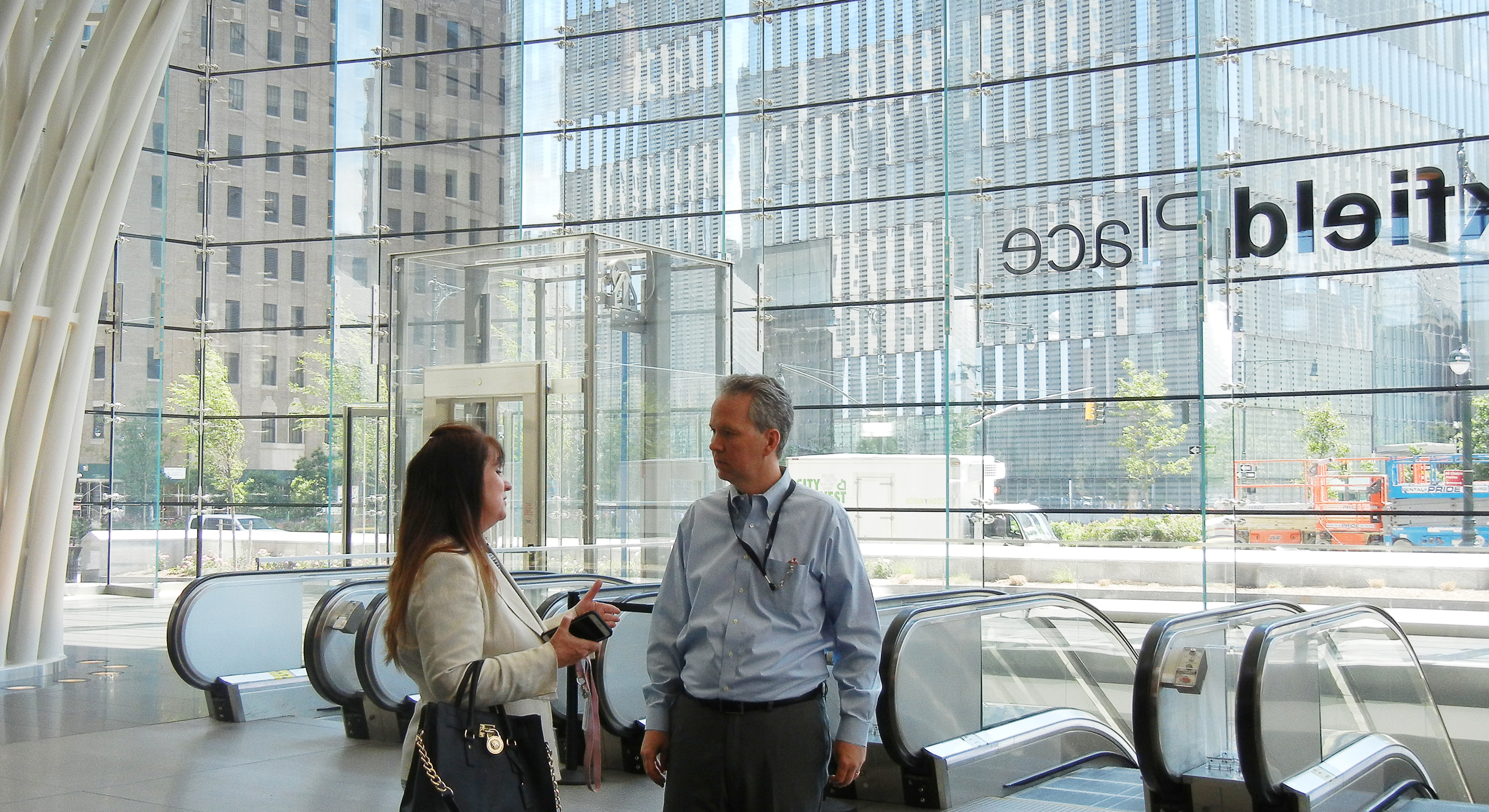
CBP employees discuss agency operations on the 64th floor sky lobby of One World Trade Center. From left to right, Agriculture Operations Manager Bruce Cheong, Supervisory CBP Officer Francesco Racanati, CBP Officer Donald Josey, National Import Specialist Associate Nina Rohan, National Import Specialist Rosemarie Hayward, and CBP Officer Michael Vernon. Photo by Marcy Mason
Nina Rohan yearned to go back. “For the longest time, I wanted to go home to the World Trade Center, but then when I got there, I had mixed feelings. I didn’t expect to feel the way I felt,” said Rohan. “It’s like they say, ‘You can’t go home again.’ Well, you can go home again. It’s just going to be different, and it doesn’t feel the same.”
Little by little, though, Rohan is getting back into a routine. “Now I stop at the old deli I used to go to and get a cup of coffee. I’ve been finding places again,” she said.
And there are other pluses. CBP’s new offices are sleek, high-tech and modern. “There’s a lot of window space and a lot of light coming in. Our old place was dark. Everything here is new and light and airy,” said Faingar. “In a word, it’s energizing.”
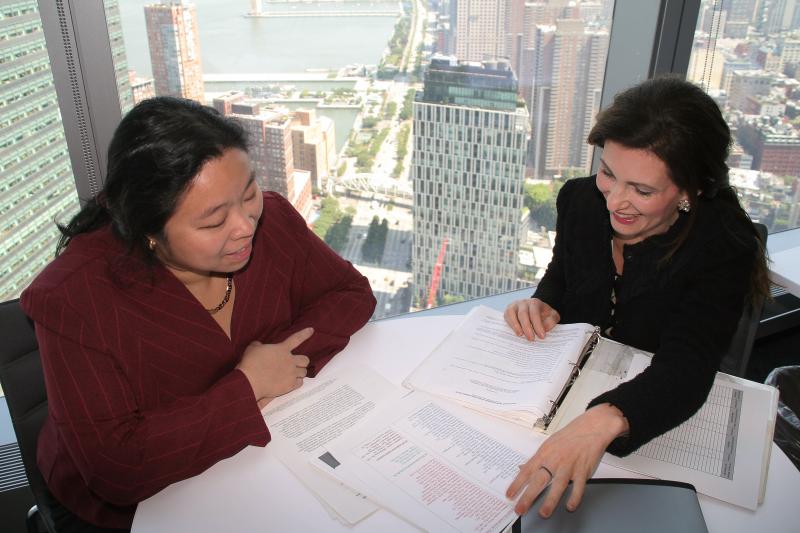 | 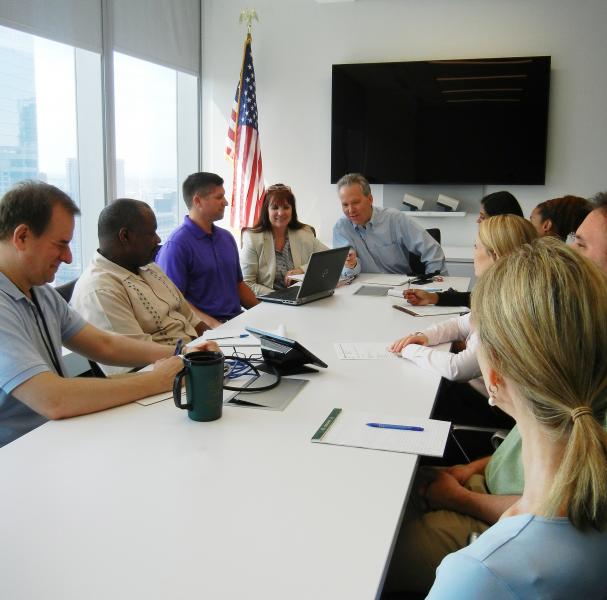 |
| Collaborating on a project, Yin-Yee Chan, international trade specialist, left, and Denise Faingar, national commodity specialist branch chief, are two of the CBP employees who returned to the World Trade Center after 15 years. Photo by Colleen Piccone | CBP’s New York legal team meet in one of the agency’s One World Trade Center conference rooms. From left to right, Frank Sharp, Philip Lamb, Brian McClintock, Colleen Piccone, Todd Smith, Bena Varughese, Kim Stephenson, Suzanne Almetica, Daniel Doeschner, and Jeanmarie Ressa. Photo by Marcy Mason |
The neighborhood, although still in a construction mode, is vibrant too. “It’s a nicer part of the city. Everything here is brand new,” said Smith. “There are a lot of good shops and restaurants. The downside is it’s costing me $12 to get a sandwich for lunch. Everything is ridiculously expensive,” said Smith. “But it’s just a much nicer experience to go out at lunchtime and in five minutes, I can be out by the Hudson River.”
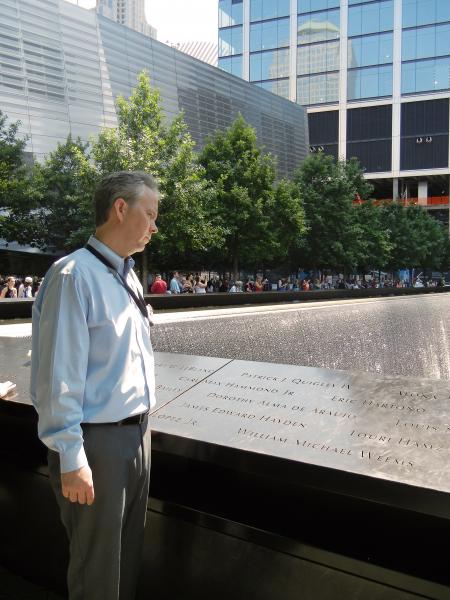
Todd Smith, takes a moment to reflect on returning
to the World Trade Center. Photo by Marcy Mason
The 9/11 Memorial, a large, public plaza directly south of One World Trade Center, is a solemn reminder of the tragedy that took place on the site 15 years ago. Two square-shaped, recessed pools with waterfalls cascading down the sides are designed in the footprints of the towers that went down. Engraved along the rim of the pools are the names of every person who died in the 1993 and 2001 terrorist attacks on the World Trade Center, Pentagon, and United Airlines Flight 93. “Sometimes there is a flag by a name or a flower. I try to make it a point every day to see the name that somebody has put a marker by that day,” said Piccone. “Because with our rapid news cycle, everything becomes old news very quickly. But I think for our mission, for the people who work here, it is a constant reminder of how important what we do is.”
Beyond that, the site has personal significance for everyone. “For me, my life has come full circle,” said Piccone. “The World Trade Center has always been a part of my life, and it’s just like coming home.”

